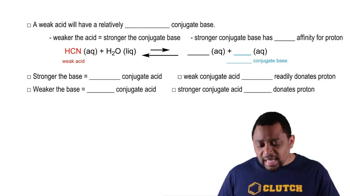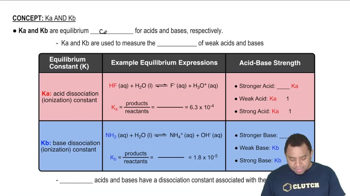Here are the essential concepts you must grasp in order to answer the question correctly.
Weak Acid and Conjugate Base
HF (hydrofluoric acid) is a weak acid that partially dissociates in solution, while NaF (sodium fluoride) provides the conjugate base F-. The presence of both a weak acid and its conjugate base in solution creates a buffer system, which helps maintain a relatively stable pH when small amounts of acid or base are added.
Recommended video:
Conjugate Acid-Base Relationships
Henderson-Hasselbalch Equation
The Henderson-Hasselbalch equation is a mathematical formula used to calculate the pH of a buffer solution. It is expressed as pH = pKa + log([A-]/[HA]), where pKa is the negative logarithm of the acid dissociation constant (Ka) of the weak acid, [A-] is the concentration of the conjugate base, and [HA] is the concentration of the weak acid.
Recommended video:
Henderson-Hasselbalch Equation
Acid Dissociation Constant (Ka)
The acid dissociation constant (Ka) quantifies the strength of a weak acid in solution. It is defined as the equilibrium constant for the dissociation of the acid into its ions. For HF, the Ka value is essential for determining the pKa, which is needed in the Henderson-Hasselbalch equation to calculate the pH of the buffer solution.
Recommended video:
Characteristics of Ka and Kb
 Verified step by step guidance
Verified step by step guidance

